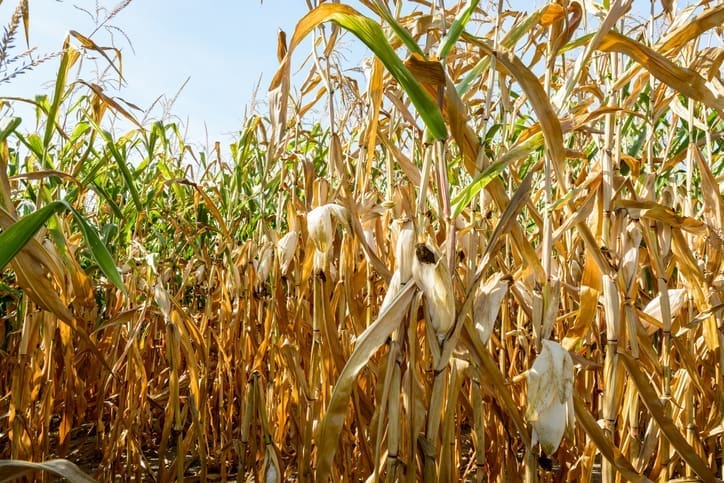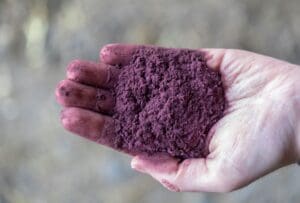The conflict in Ukraine is confronting us with political and environmental realities on how food production needs to liberate itself from over-dependence on fossil fuels and imports.
The World Food Programme reports that Russia and Ukraine combined account for just under 30% of global wheat exports and the Observatory of Economic Complexity states that in peacetime, Ukraine alone produces 13% of global corn and 45% of global crude sunflower seed oil exports. On March 9th, the Ukrainian government announced that it was banning exports of rye, barley, buckwheat, and millet until the end of the year as a result of farmers ‘fighting rather than planting’. This prompted warnings of a new ‘hunger pandemic’ from the World Food Programme.

A taste of things to come
According to research from the 2021 Mintel Sustainability Barometer, just 28% of the consumers surveyed across 16 countries cited ‘food shortages due to drought or crop failure’ as one of their top five environmental concerns. By way of comparison, 52% opted for plastic pollution. Whilst the current disruption to food production in Ukraine is the result of military intervention rather than environmental factors, it presents a likely forecast of the more frequent climatic system pressures to come, with peacetime harvests in the breadbaskets of the world increasingly likely to be impacted by drought.

According to the Woodwell Climate Research Centre, by 2030 crop yield failures will be 4.5 times higher than they are now and the world will be facing major rice or wheat harvest failure every other year – with soybean and maize harvests even more vulnerable. Wheat is especially water-dependent and, in India, for example, 97% of crops are already grown in areas of high water stress, defined as those where almost all resources are being used up.
Among the countries imposing severe sanctions against Russia, many are maintaining a degree of Russian oil supply, highlighting our dependence on imported fossil fuels and this also applies to agriculture. Russia is the world’s biggest exporter of synthetic fertilisers and with prices soaring in a single week from £650 a tonne towards £1,000, farmers may be forced to use organic fertilisers from livestock holdings. Some farmers may try to use more locally-sourced organic fertilisers from livestock or anaerobic digesters in an agricultural take on the ‘freedom energy’ ideal, built on hopes that the conflict will – in the mid-term at least – steer us towards clean, local energy sourcing.
Scientific solutions, natural principles
The Ukraine conflict presses home a broader need for more dependable and durable foods, embodied by saline and alkali-resistant ‘seawater rice’ developed in Jinghai, China, by scientists faced with rising sea levels and a goal of feeding 80 million more people.
From a consumer perspective, it’s encouraging that research from the 2021 Mintel Sustainability Barometer shows that 64% of people globally perceive ‘food crops genetically modified to withstand pests and/or climate change’ as having a high-to-moderate positive impact on the environment, but more broadly a lack of faith in science is a major obstacle. Just 45% of global consumers agree that ‘science can provide solutions to the climate crisis’, whilst only 48% believe ‘food grown in labs (eg lab-grown meat) can have a high to moderate positive impact on the environment’.
All of this reflects consumers’ enduring faith in ‘natural’, even when natural is finite, threatened and unsustainable. In reality, future solutions will likely depend on applying scientific innovation to nature’s infallible design principles.
Within the sustainability community, this boils down to three key practices
- Waste equals food since in nature one organism’s waste (including its death) is the input for another organism – creating a cradle-to-cradle system that recycles waste into something new.
- Use current solar income and learn from how organisms thrive on energy from the sun and how plant life manufactures food from sunlight. By using solar energy more broadly, agriculture can do the same.
- There is a need to celebrate diversity and mimic how ecosystems and their organisms fit into a system to create a functioning whole.
Nurturing nature in action
The good news is that these design principles have been in action way before humans turned up and we’re already managing to turn them to our own ends – improving efficiencies in agricultural inputs and outputs to raise yields and reduce waste.
Let’s start with waste equals food. At the centre of this is a prudent – and indeed lucrative – desire to maximise resources. At China’s Rizhao Eco-Industrial Park (REDA), the state insists on industrial symbiosis as outlined in the country’s Circular Economy Promotion Law and so a fertiliser factory is fed with vinasse, a byproduct of sugar, from a nearby beer brewery. In the UK, the same principles are at work at a commercial level at British Sugar’s Wissington factory, where bi-products from sugar beet processing are turned into organic products to correct soil acidification, beet sugar syrup into renewable fuel and yeast into animal feed.

In Finland, Solein protein powder presents a great example of solar income harnessed by science. Its maker Solar Foods admits it is “following nature’s playbook”, using a twist on traditional fermentation techniques to feed a microbe with just air and electricity – in a process that claims to be twenty times more efficient than photosynthesis itself.
To celebrate diversity, governments and companies must conserve biomass and resources and stem a tide of extinction that has seen 27,000 animal and plant species lost globally every year, according to the WWF.
Companies must also work to future-proof diversity and expand our options. At Platåberget Mountain in Norway, the Svalbard Global Seed Vault stores one million crop varieties from 5,000 species (two-fifths of all varieties worldwide) to safeguard them against extinction. Their ethos is: “Crop diversity is the foundation of our food production. It allows our food crops to adapt to the climate and population changes that are coming. The seeds contain the raw material that scientists and plant breeders might need to improve the yield, resilience or disease resistance of the agricultural varieties that farmers plant.”
We see diversity celebrated at a consumer goods level through brands like the UK’s Bird and Wild Coffee, which resolutely stick to natural, sustainable shade-grown coffee practices that preserve the natural environment in favour of the terminal short-termism of sun-grown monoculture.
Diversity isn’t just for staples either. In Bordeaux, France, VitAdapt is planting new grape varieties to combat climate change and break a hegemony where 12 French grapes make up 80% of the global market. When, in fact, 6,000 varieties of vitis viniferea – the common wine grapevine – exist to be explored and exploited.
Harnessing nature’s resource efficiencies
Nature can teach us a thing or two about resource efficiency as well. Consider that crickets are 60% protein by weight and reach adulthood in just seven weeks. If we just consider feed inputs alone, they are 12 times more efficient than cows at generating protein, suggesting how they can, at the very least, supplement current approaches to production.

If we do want to keep rearing beef, then feeding them with seaweed – as Volta Greentech is doing in Stockholm – can reduce methane emissions by 80% and contribute to a latent form of aquatic agriculture that can nurture nature’s carbon capture capabilities at an unprecedented scale. The Smithsonian Institute asks us to imagine a world where 9% of the ocean is covered in seaweed farms capturing 19 Gigatonnes of carbon a year (half of our emissions) and generating 12 Gigatonnes of biomethane gas for fuel.
Seaweed may seem a long way from Ukrainian grain right now, and cultivating the seabed at this scale may seem fanciful even for Jules Verne, but embracing nature’s principles – with scientific stimulation and capacity building – can liberate us from a crippling dependence on ‘man made’ farming methods.
To learn more about global consumers’ changing attitudes, preferences and behaviours related to sustainability, download the free 2021 Mintel Sustainability Barometer and stay tuned for details on the release of the 2022 Sustainability Barometer in June, including an episode on Mintel Little Conversation Podcast to preview the results in May.
For more information about how Mintel Consulting can help your brand tap into the latest sustainability trends to grow your business, please contact us.








































